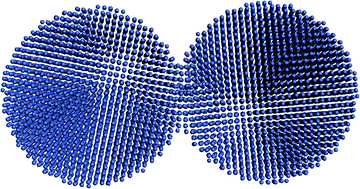Thermostructural behaviour of Ni–Cr materials: modelling of bulk and nanoparticle systems†
Abstract
The thermostructural properties of Ni–Cr materials, as bulk and nanoparticle (NP) systems, have been predicted with a newly developed interatomic potential, for Ni/Cr ratios from 100/0 to 60/40. The potential, which has been fitted using experimental data and further validated using Density Functional Theory (DFT), describes correctly the variation with temperature of lattice parameters and the coefficient of thermal expansion, from 100 K to 1000 K. Using this potential, we have performed Molecular Dynamics (MD) simulations on bulk Ni–Cr alloys of various compositions, for which no experimental data are available. Similarly, NPs with diameters of 3, 5, 7, and 10 nm were studied. We found a very rapid convergence of NP properties with the size of the systems, showing already the 5 nm NPs with a thermostructural behaviour similar to the bulk. MD simulations of two 5 nm NPs show very little sintering and thermally induced damage, for temperatures between 300 K and 1000 K, suggesting that materials formed by agglomeration of Ni–Cr NPs meet the thermostructural stability requirements for catalysis applications.



 Please wait while we load your content...
Please wait while we load your content...